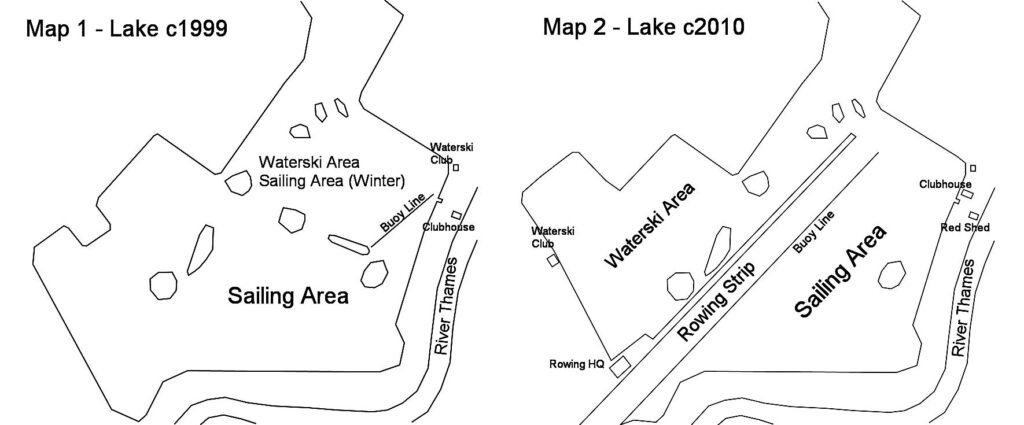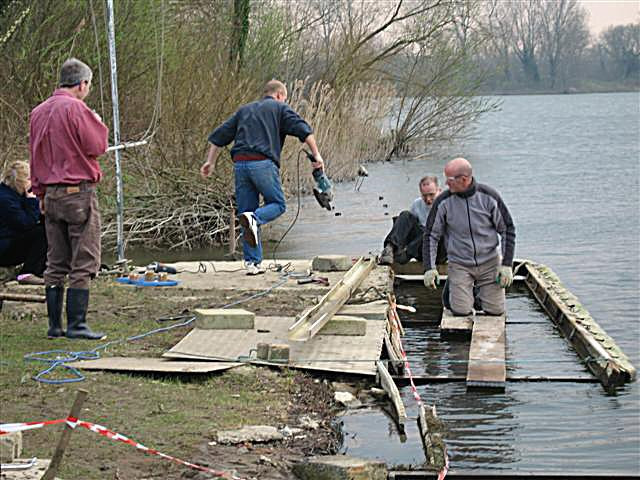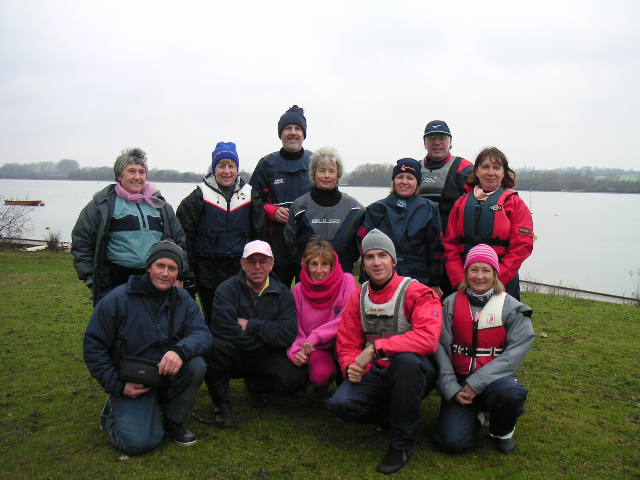Recent Club History 2000 – present
Following on from Brian Frost’s 1995 Club history, with the later additions by Clive and Michael Evans, this article summarises the major events in the history of RSC between 2000 and the 70th anniversary of the Club in 2024.
The early years of the 21st. century marked a large number of changes in the facilities and operations of the Club. New buildings, rearrangement of the usage of the lake, formalised training programs and increasing social activities all benefited the Club activities and helped to reverse the trend of declining membership that had occurred in the years prior to the turn of the century.
Many of these changes were made possible as a consequence of the wider alterations brought about by the construction of the Redgrave-Pinsent rowing strip. At the start of this period the Club’s sailing water during the summer months comprised the south-western portion of the lake, beyond a line of islands across the middle of the lake (map 1). The Isis water ski club had the use of the area nearer the current Clubhouse. This arrangement had a number of disadvantages. To reach the race area from the jetty it was necessary to sail out and back within a buoyed channel, occasionally tedious if the wind direction was adverse. Sailing was also largely out of sight of those ashore. During the winter, the Club had use of the whole lake.
The rearrangement (map 2) made for a much more useable sailing area. Two of the islands were dredged out giving a clear access to most of the lake from the launching area and a less obstructed wind, particularly from the prevailing south westerly direction. With the waterskiers moving beyond the rowing strip, wash from the towing boat was also no longer a factor.

With a new 30-year lease for the use of the lake it was possible to get a Sport England grant for a purpose built Clubhouse near the water and giving a view of most of the sailing area. Construction of this was started in 2003 under the leadership of Peter Rose. The design by architect and Club member Jeremy Bell was raised to a level that took account of the height of possible floods (PICTURE). Much of the fitting out was undertaken by Club members. The plumbing and electrical work, barrowing in sand to bury the underfloor heating pipes, construction of the kitchen area, installation of the sliding doors and much of the painting were all done in-house.
As outlined in Brian Frost’s earlier history, the Clubhouse at the beginning of this period was a building near the bank of the Thames facing the river, reflecting the earlier sailing activities of the Club. One Saturday night in 2004 this burnt to the ground; those turning up for racing the next day were confronted only by smoking ruins. Surprisingly, one outboard motor still in working order was later rescued, having survived the conflagration inside the thick metal cabinet that is still used to store the powerboat fuel tanks. At the time the new Clubhouse was still under construction but as the waterskiers had already decamped to their new home their old buildings became the Club’s temporary base.
Funded from the insurance, the current maintenance building was built on the same site. Of the two colours available, the current one was chosen at the insistence of the local authority during the planning approval process, leading to its christening as the “Red Shed”. Oddly, much later I talked with a gentleman walking through the Club grounds who said that he was one of those responsible for pushing for that colour and conceded that, having seen it, the green option originally proposed would probably have been better!
Amongst other uses, the space available in the Red Shed now allowed the Club powerboats to be stored ashore with their engines mounted. Previously they were kept afloat on buoys on the lake. The duty of the OOD team on race days then was to row a small boat out, climb across and paddle the powerboat, often awash with rainwater, back to the jetty. Once there the outboard engine then had to be lifted in from the jetty. At the end of the event the whole process had to be repeated.
In early 2007, an episode of the recurrent flooding of the lake, coupled with rough weather caused major damage to the jetty that had been constructed in 1987 (see previous history page). The decking was displaced and much of the substructure found to be rusted through. A number of volunteer members cut all this away and prepared the support beams for a new deck, all the while balancing on narrow boards just above the water (see picture). In good recycling practice, some of the old metal decking plates from the jetty were later repurposed by Steve Sharp as a breakwater to replace the badly eroded lake shore in front of the Clubhouse. Around a dozen years later this was replaced with pilings during the Covid epidemic.

Following this, the last major additions to the Club’s facilities with the construction of a second slipway at the southern end of the main jetty. Clearance of an area that had become rather neglected also extended the boat parking area south of the Red Shed to accommodate the increasing membership. Immediately prior, the boat park only consisted of the current rows A-G.
In the years 2015 and onwards there was a feeling that the size of the Clubhouse was becoming too small for the increasing membership and that the limited space impacted both social events and training courses. Plans were made for two alternative building extensions and some ground surveys made. After the membership had been canvassed for their preference, the choice was for a single-level construction over lake-facing portion of the veranda, extending it outwards and further along the lake shore. But the idea eventually foundered; the inability to obtain a long-term extension of the lease at this time precluded the obtaining of any grant funding that would be needed to supplement the Club’s own resources.
Marquees have since been used to provide an alternative way to provide covered space for various activities. This year the veranda was rebuilt and its roof extended to provide full cover.
At the start of the period of this history, beginners were taught to sail in internal training courses; by now organised by Jeremy Bell. In 2005, under his direction the Club progressed towards obtaining RYA registration as an official training centre. The ability to offer recognised sailing qualifications was seen as a means of regrowing the Club membership which had been dropping away for some years. Approval required a small team of members to obtain formal RYA qualifications as sailing trainers and powerboat drivers. The support boat also had to be upgraded from the original 4HP outboard engines that the Club had been operating until then. With all the admin requirements in place, registration was granted and the first RYA dinghy course held in 2006. In early 2010, Jon Clay took over the position of Training Principal at the Club and remained in that position until 2023, building up the range of courses, equipment and personnel.
As well as formal RYA training, a number of related activities have been introduced. January 2004 saw the inauguration of the Pink Fleet as means of improving sailing skills, primarily for ladies initially although men soon joined in. Cooked breakfasts before sailing have been a frequent feature of the monthly event. The Pink Fleet also became a focus for many social activities such as barbeques, the Campsail event, Bonfire Night and Christmas parties.

Pink Fleet Inaugural Meeting Jan 2004
Front Row – Steve Sharp, Jeremy Bell (instructors)
Monica Beer (current Pink Fleet Captain), ?, Kris Allen (original Captain). Back Row – other Pink Fleet participants
Similarly, a Pirates Club was organised in 2007 “For persons aged 8-20” who already had some sailing ability; with the aim of building sailing skills and confidence afloat by means of waterborne games instead of structured training. Sadly this has been in abeyance since 2017.
A further significant change to the Club came about as a result of the process that led to the closure of the Black Swan Sailing Club (BSSC) at Hurst. After some discussions as to how best BSSC members could be accommodated, around two dozen experienced sailors joined the RSC in 2011, reinvigorating the racing scene and joining a few others who had moved previously. In anticipation of the extra numbers, clearance of the overgrown area between the clubhouse and the now vacant waterski buildings made a space that could be used for extra car parking. More boat parking area was also opened up, now reaching the southern extent of the Club grounds, and a compound created to store road trailers.
The number of Club boats available to members was increased by the acquisition of set of Pico dinghies from the BSSC closure. Some additional Toppers had also been purchased and a second Sport 14 was obtained, allowing some of the older and more varied Club boats to be withdrawn. All the boats now used were equipped with centre mainsheet rigging, simplifying training and making progression to higher performance dinghy designs easier.

A fleet of Optimist dinghies also came from BSSC and Karen Smailes established a new program of youth and junior training and also progressed some young people towards becoming instructors themselves. This led to young sailors participating both in a Club Junior Regatta and in interclub sailing competitions.
Fleet racing, the decline of which appears to have been a concern in the earlier history, had mostly disappeared by this period, largely due to the many different designs of dinghies now owned by members. The main Club race series were now contested by a varied fleet although Lasers have been in the majority. Single design races carried on for a period as single-event cups but more recently have been limited to occasional open events for hosting visiting owners of a particular dinghy class.
The regular Sunday morning events remained for several years in the traditional format of single handicap races in the winter and summer seasons with pursuit races for the spring and autumn. Long races of up to 90 minutes with mixed fleets tended to become very spread out, so in June 2015 the Sailing Secretary, Newton Anthony, introduced an alternate arrangement for the Summer Series with the time split between two, shorter, races; one in pursuit format, followed by a handicap. This proved successful so the same arrangement was later adopted for the other seasonal contests. Wednesday evening races in the summer months and the various Cup events have continued throughout with only minor changes. In recent years, a separate summer series for younger sailors has taken place before the adult race on Wednesday evenings and two Junior Regattas are held each year.
Other events have been trialled on occasion, such as Sunday afternoon races, but these have not as yet become established as permanent additions to the programme.

Radio-controlled model yacht sailing competitions have continued throughout this period. Until recently, the International One Metre (IOM) class was used exclusively. The smaller Dragonforce 65 design has become increasingly popular since its introduction to the Club in 2020 and a number of dinghy sailors have now acquired these to sail in Club races in addition to their full-sized boat.
In summary, while the emphasis is still largely on the regular racing events, the Club has evolved over the last two dozen years into one having a much more varied set of activities than hitherto. People now also take to the water in canoes, paddleboards and windsurfers and even, in a few cases, dinghies that have been built from a collection of wood and a set of plans. Families with children have the opportunity to sail together and there are regular times in the week for people to sail socially and who no longer relish the hurly-burly of competitive racing. Now all that is needed is a reduction in the weed!
Brian Moore, August 2024

